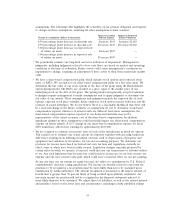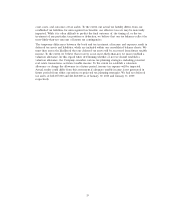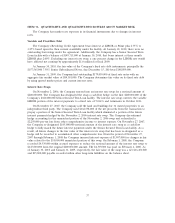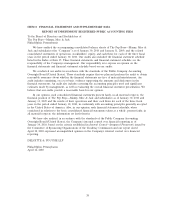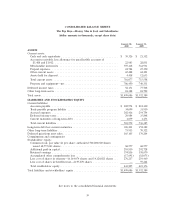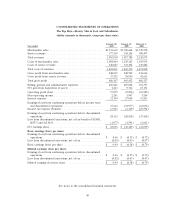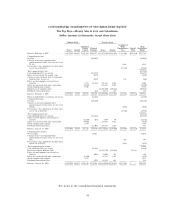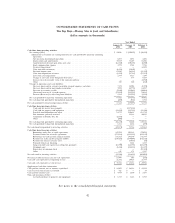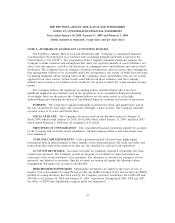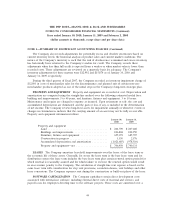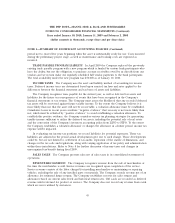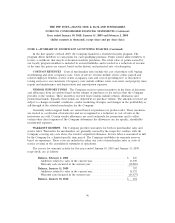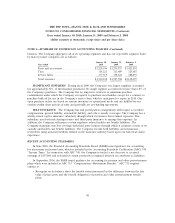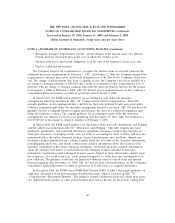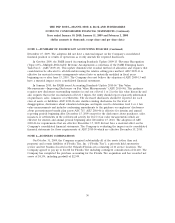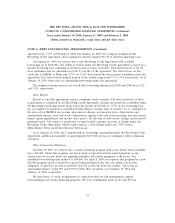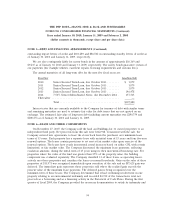Pep Boys 2009 Annual Report Download - page 102
Download and view the complete annual report
Please find page 102 of the 2009 Pep Boys annual report below. You can navigate through the pages in the report by either clicking on the pages listed below, or by using the keyword search tool below to find specific information within the annual report.
THE PEP BOYS—MANNY, MOE & JACK AND SUBSIDIARIES
NOTES TO CONSOLIDATED FINANCIAL STATEMENTS (Continued)
Years ended January 30, 2010, January 31, 2009 and February 2, 2008
(dollar amounts in thousands, except share and per share data)
NOTE 1—SUMMARY OF SIGNIFICANT ACCOUNTING POLICIES (Continued)
The Company also records adjustments for potentially excess and obsolete inventories based on
current inventory levels, the historical analysis of product sales and current market conditions. The
nature of the Company’s inventory is such that the risk of obsolescence is minimal and excess inventory
has historically been returned to the Company’s vendors for credit. The Company records these
adjustments when less than full credit is expected from a vendor or when market value is lower than
recorded costs. These adjustments are reviewed on a quarterly basis for adequacy. The Company’s
inventory adjustments for these matters were $12,992 and $15,874 as of January 30, 2010 and
January 31, 2009, respectively.
During the third quarter of fiscal 2007, the Company recorded an inventory impairment charge of
$32,803 in costs of merchandise sales for the discontinuance and planned exit of certain non-core
merchandise products adopted as one of the initial steps in the Company’s long-term strategic plan.
PROPERTY AND EQUIPMENT Property and equipment are recorded at cost. Depreciation and
amortization are computed using the straight-line method over the following estimated useful lives:
building and improvements, 5 to 40 years, and furniture, fixtures and equipment, 3 to 10 years.
Maintenance and repairs are charged to expense as incurred. Upon retirement or sale, the cost and
accumulated depreciation are eliminated and the gain or loss, if any, is included in the determination
of net income. The Company reviews long-lived assets for impairment annually or whenever events or
changes in circumstances indicate that the carrying amount of an asset may not be fully recoverable.
Property and equipment information follows:
January 30, January 31,
2010 2009
Property and equipment
Land ...................................... $ 204,709 $ 207,608
Buildings and improvements ..................... 826,804 822,950
Furniture, fixtures and equipment ................. 695,072 685,707
Construction in progress ........................ 1,550 2,576
Accumulated depreciation and amortization .......... (1,021,685) (978,510)
Property and equipment—net .................... $ 706,450 $ 740,331
LEASES The Company amortizes leasehold improvements over the lesser of the lease term or
the economic life of those assets. Generally, for stores the lease term is the base lease term and for
distribution centers the lease term includes the base lease term plus certain renewal option periods for
which renewal is reasonably assured and for which failure to exercise the renewal option would result
in an economic penalty to the Company. The calculation of straight-line rent expense is based on the
same lease term with consideration for step rent provisions, escalation clauses, rent holidays and other
lease concessions. The Company expenses rent during the construction or build-out phase of the lease.
SOFTWARE CAPITALIZATION The Company capitalizes certain direct development costs
associated with internal-use software, including external direct costs of material and services, and
payroll costs for employees devoting time to the software projects. These costs are amortized over a
44


